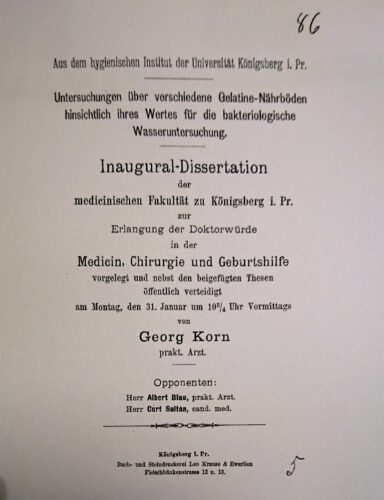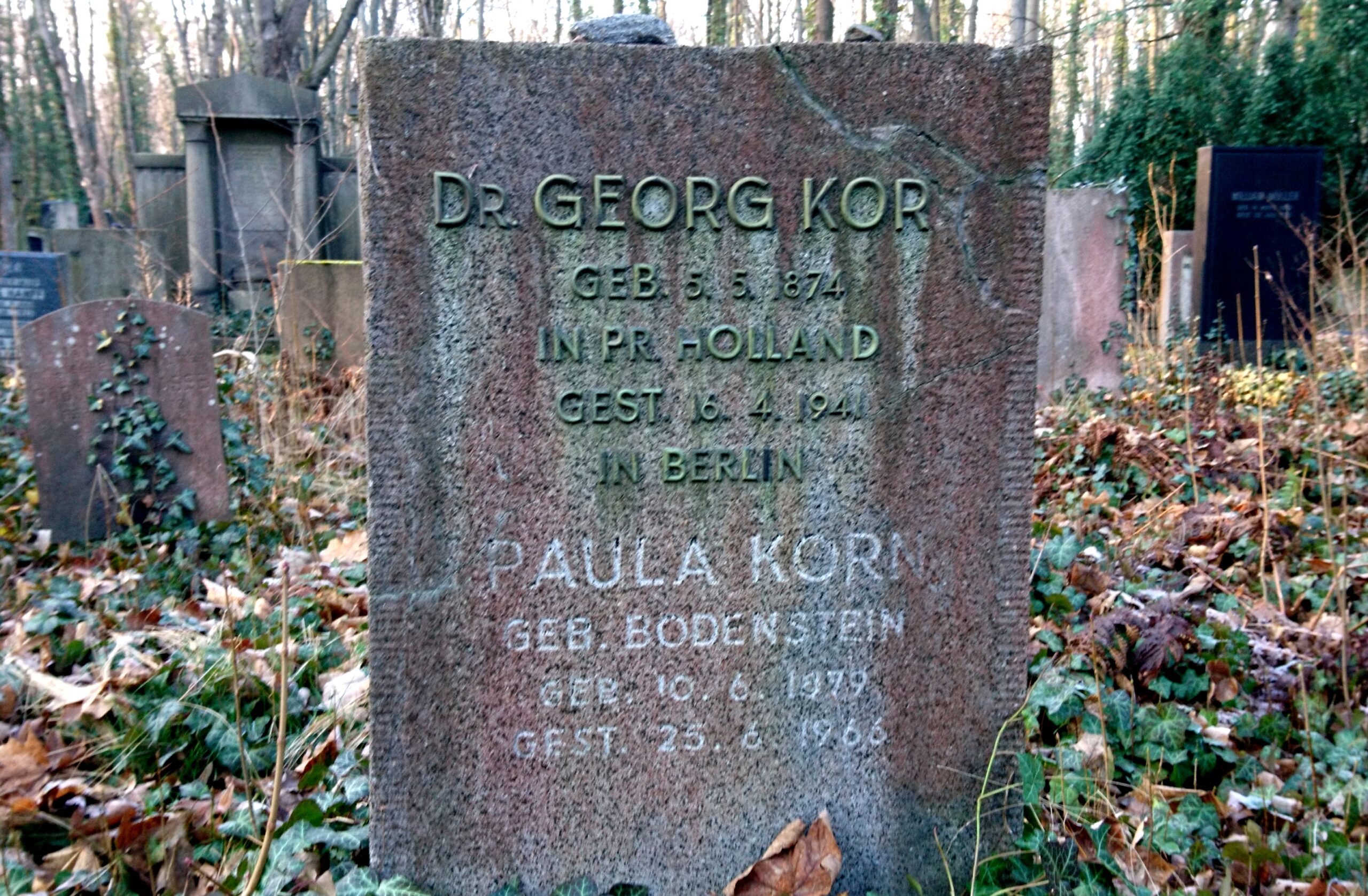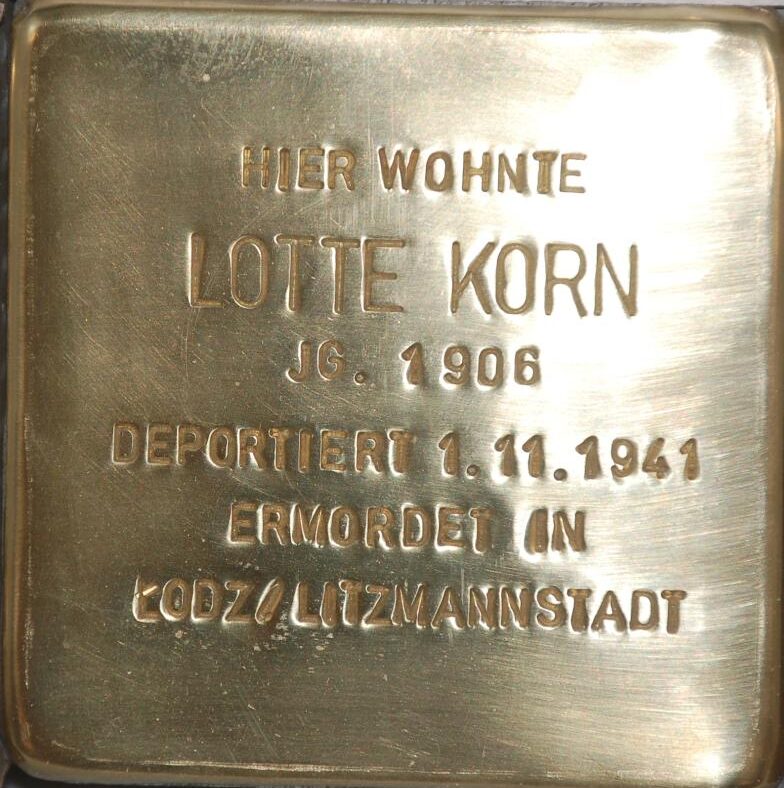Dr. med. Georg Korn
- Prussian Holland in former East Prussia, today Pasłęk, Poland, 05.05.1874
- Berlin, 16.04.1941
- Member since 1925
- Kaliningrad
- Specialist doctor in gastrointestinal and metabolic diseases
Georg Korn was born on 5 May 1874 in Prussian Holland in former East Prussia as the son of the general practitioner and medical councillor Dr. Sigismund Korn and his wife Hulda, née Fürst. The family was of Jewish faith. Sigismund Korn was also a municipal doctor for the poor and caretaker of the infirmary in what was then Prussian-Holland.
Education and Workplaces
Georg Korn first received private tuition, then attended the city school of Prussian Holland and, from Easter 1886, the Royal Grammar School in Elbing (today Elbląg, Poland), from which he graduated on Easter 1892. Korn then began to study medicine, initially for two semesters in Munich, before moving to Königsberg, now Kaliningrad, Russia. He completed the state examination there in January 1898 and was awarded his doctorate the same month. His doctoral thesis, “Untersuchungen über verschiedene Gelatine-Nährböden hinsichtlich ihres Wertes für die bakteriologische Wasseruntersuchung”, had been suggested by the bacteriologist and hygienist Erwin von Esmarch, a student of Robert Koch.
Korn received his medical licence in 1898. He received his training and early specialisation under Ismar Boas in his Berlin polyclinic for stomach, intestinal and metabolic diseases. He worked as a practising specialist for gastrointestinal and metabolic diseases in Königsberg from 1902. Georg Korn was one of the very early specialists to set up practice in the then new field outside Berlin. During the First World War, Korn was assigned to the Königsberg garrison doctor as an employee.
Georg Korn is listed in the first membership list of the Society for Digestive and Metabolic Diseases when it was formally established in 1925. He was also represented in the Archiv für Verdauungskrankheiten (“Boas Archive”) in 1925 with a small piece in response to an article by Hermann Strauss, Berlin.
In addition to his practice, Korn cared for his patients as an attending physician at a colleague’s private clinic. Due to his expertise in his field, he was called to consultations in Kowno/Kaunas and Vilnius, today Lithuania, as well as Minsk, today Belarus.
Georg and Paula Korn were well connected in Königsberg at the time. They ran an open house, which was frequented by artists. Georg Korn was also a generous patron of the arts.
Since 1933
As a Jew, the 59-year-old Georg Korn was subjected to persecution and anti-Semitic attacks by the National Socialists once the Nazis came to power. He lost his licence to practise medicine. The number of his patients decreased continuously. “Since my husband was Jewish, his practice declined year by year after 1933. Most of his colleagues were no longer allowed to refer patients to him,” says Paula Korn [curriculum vitae on the compensation application of 5 November 1954, Berlin Compensation Authority, Reg.No. 262 401, E2, BEG].
In the Reich Medical Calendar 1937 Georg Korn – marked as a Jew – is still listed as a specialist for gastrointestinal diseases. His licence to practise medicine was revoked on 30 September 1938. Korn was forced to give up his practice.
The Korns left Königsberg in the autumn of 1938, after they had been warned of being arrested. They left behind their home furnishings, and from then on lived in modest conditions in several different flats in Berlin. Their efforts to obtain visas for their departure from Germany from 1938 onwards were not successful.
Georg and Paula Korn’s last address in Berlin was Landshuter Strasse 4, where they lived together with their daughter Lotte Korn in one room. Lotte Korn had been working as a medical-technical assistant at the Berlin practice of Dr. med. Victor-Aronstein since 1935. Lotte Korn was closely associated with Aronstein and married him in 1941.
Georg Korn was admitted to the Department of Internal Medicine of the Jewish Hospital Berlin (Medical Director Prof. Prof. Hermann Strauss). The 77-year-old Georg Korn died at the hospital the following day, on 16. April 1941. His surviving gravesite is located at the Jewish Cemetery Berlin-Weissensee.
His daughter Lotte Korn-Aronstein and Dr. Victor Aronstein were deported from Berlin to the Litzmannstadt (Łódź ) ghetto on 1 November 1941. Their traces disappear in 1944 – both perished in the Holocaust.
Georg Korn’s wife Paula, née Bodenstein, born in Berlin in 1879, lived alone in Berlin after her daughter’s deportation under the constant threat of being deported herself. She decided to flee Germany in April 1942 with four other Jewish women, among them the writer Gertrud Kantorowicz. In Berlin, Paula Korn had joined Paula Hammerschlag, who lived in the same house at Landshuter Strasse 4 and for whom her son, who lived in Switzerland, had organised an escape. The group travelled to Hohenems via Munich and Bregenz. When they tried to cross the border into Switzerland at Diepoldsau on 6 and 7 May 1942, the women were stopped by German border police. Only Paula Korn managed to escape to Switzerland. The four other women were imprisoned and later deported. None of them survived. Paula Korn was briefly imprisoned at Rheineck prison, among other places, for illegally crossing the border into Switzerland. She was interned at the Israelite Girls’ Home in Basel from 11 May 1942. She received support from a Jewish relief organisation (Verband Schweizerischer jüdischer Fürsorgen). The Basel theologian Professor Ernst Staehelin and his wife Gertrud Staehelin-Kutter arranged for Paula Korn to be placed in the old people’s home for women at the deaconesses’ home in Basel-Riehen in September 1943. Paula Korn was able to join her son in the USA on 12 February 1947. She died in New York on 25 June 1966. Her urn was buried next to her husband’s grave at the Jewish Cemetery Berlin-Weissensee in 1967.
Their son Heinrich Georg Korn (born on 8th August 1904) was able to flee from Berlin to the USA via Cuba (Havana) in October 1937. He reached California on 12 November 1937. He initially called himself Henry George Korn in the US. He later took on his wife’s name and referred to himself as Henry Cordy and became well-known as a concert and opera singer (baritone) together with his wife. He died in New York on 23 November 1965.
Acknowledgements
We would like to thank Sabine Hank, Archive Foundation New Synagogue Berlin/Centrum Judaicum, for locating the medical records of Dr. Georg Korn at the Jewish Hospital Berlin from 15/16 April 1941. We would also like to thank Dr. Hanno Loewy and Raphael Einetter, Jewish Museum Hohenems, for exchanging ideas, for their advice and for their cooperation.


